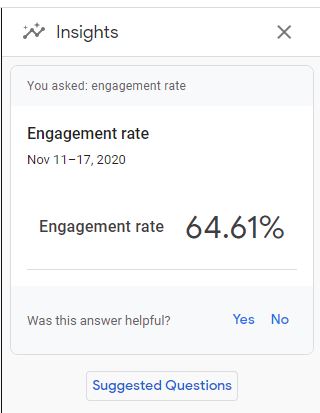Where did my Bounce Rate go in Google Analytics 4?
With the new version of its web analytics platform Google Analytics 4, Google is reacting to important future topics and changes in the market and user behavior. Besides numerous innovations and additional features, which we summarized in our post on why and how to migrate to Google Analytics 4, it is also noticeable that a function for users of the new version of Google Analytics is no longer available or at least not in the form we all got used to it.
Why is the bounce rate no longer available? Or is it?
With an update from July 11, 2022 Google has actually brought back a well-known metric: the bounce rate has been reintroduced and is now available again in explorations and customized reports. Standardized reports, on the other hand, continue to show the engagement rate. In the new version of Google Analytics 4, users until very recently could no longer retrieve the bounce rate of their website. Why this feature has been removed in the first place and what effect the change has on the use of Google Analytics is explained in this article. The now “again” available bounce rate in GA4 is actually the inverse value of engagement rate, which makes the added value of this metric questionable. So keep in mind to not confuse the bounce rate in Google Analytics 4 with the “old” bounce rate as it was still calculated in Universal Analytics.
In Universal Analytics, the bounce rate was used to measure user engagement on your website. The bounce rate measures the percentage of visitors to a website who leave the page without having clicked another button on the page. This metric can help users of the old version of Google Universal Analytics to get an impression of the engagement of visitors to their site. However, looking at the bounce rate alone often leads to misleading conclusions and a false representation of actual user engagement.
The bounce rate has a number of significant drawbacks, which have led to Google no longer providing this function in the new version of its analytics tool.
What are the disadvantages of using the bounce rate as a KPI?
The accuracy and meaningfulness of the bounce rate is often very questionable. As described, it measures the number of website visitors who leave the page without clicking (further). In online stores, for example, this can be an indication of whether visitors were able to find the product they were looking for on the website. If a user visits an online store and does not click on any of the products offered, this is an indication that the user has not been attracted to any of the products. But with many website contents, the bounce rate can also be misleading.
Let’s assume users click on an informative article that they have reached via a Google search, they often read the entire article, find the answer they are looking for in it and then leave the page without having clicked further. In this case, however, it is not true that the user has not found the content he was looking for. Nevertheless, the bounce rate of the respective page is increased. Visitors can therefore often be interested in the content of a website and find the information they are looking for without having to open other pages. But this is exactly what the bounce rate implies and tries to reflect – the percentage of visitors who did not find what they were looking for on the page. So for certain pages or content, a high bounce rate can falsely indicate that the page does not contain what the visitor wants and should be changed.
This will necessarily lead to the bounce rate being misinterpreted and misunderstood. Companies that measure the quality of their website by the bounce rate can derive incorrect recommendations for action from it and make changes to their website that do not represent real improvements.
Another factor that is a weakness of the bounce rate is the fact that many users visit websites via their smartphones. The typical “scrolling” of visitors on a smartphone results in many visitors staying on the same page for a long time and not clicking further, as they would probably do by viewing it on a laptop or tablet. The bounce rate can therefore also produce misleading results, especially for smartphone users.
The bounce rate can also be actively influenced. For example, it is quite easy to set a trigger that identifies a user as “non-bounce” when he has reached a certain percentage of the page by scrolling. Accordingly, it is important to deal with the goals of your own website and set up a tracking plan.
The alternative to Bounce Rate in google Analytics 4
Due to the mentioned disadvantages of the bounce rate, Google has removed it in the new version Google Analytics 4. However, not without offering an alternative for measuring user engagement for Google Analytics users.


You can either find the engagement rate in the report with the statistics on user acquisition, or you can use the “Statistics” button to query it directly.
From now on measure user engagement instead of bounce rate
With the newly introduced Engagement Rate, users should get a more accurate impression of how visitors interact with a website. The Engagement Rate is the ratio of engaged sessions to the total number of sessions on a website. This metric is designed to answer the same question as the bounce rate previously used in Google Universal Analytics, while eliminating the key disadvantages of the bounce rate.
In the new metric, “engaged sessions” are all sessions that either last longer than 10 seconds, contain a conversion event, or have more than one screen or page view. (Source: Definition in Google Analytics 4 UI).
Long stays on a website, which, as described above, do not result in a click on another page, are no longer considered to be unengaged sessions and therefore do not have a negative impact on the measurement of user engagement on a website. This gives Google Analytics 4 users a more accurate picture of whether their website contains the content users are looking for and the level of user engagement with their website.
Still want to measure the bounce rate in GA4 – is that possible?
If you still want to measure your bounce rate despite the disadvantages of the bounce rate and the available alternatives in Google Analytics 4, then this possibility still exists, even if Google Analytics 4 no longer directly maps your previously known bounce rate. You can reproduce the old bounce rate metrics by using Google BigQuery. With the numbers and information contained in it, the bounce rate can be calculated approximately. However, an exact reproduction of the previous values and a corresponding comparison with reference values can be time-consuming and only partially effective.
Bounce Rate or Engagement Rate: What is the better metric?
As described above, the engagement rate provides a more accurate picture of how well users engage with a website. The User Engagement Rate is also available via the interface in Google Analytics 4.
However, the bounce rate is a well-known metric due to its years of use. Many stakeholders might therefore still expect the bounce rate to be displayed in reports. In this case you can still report the bounce rate as described above.
However, we recommend using the Engagement Rate instead of the Bounce Rate in the future to map and measure the user engagement of a website.
If you have any questions about how you can measure or improve the quality of your website more precisely or want to migrate to the new GA4 setup, please feel free to contact us at any time. We will be happy to show you your possibilities in a non-binding consultation.




